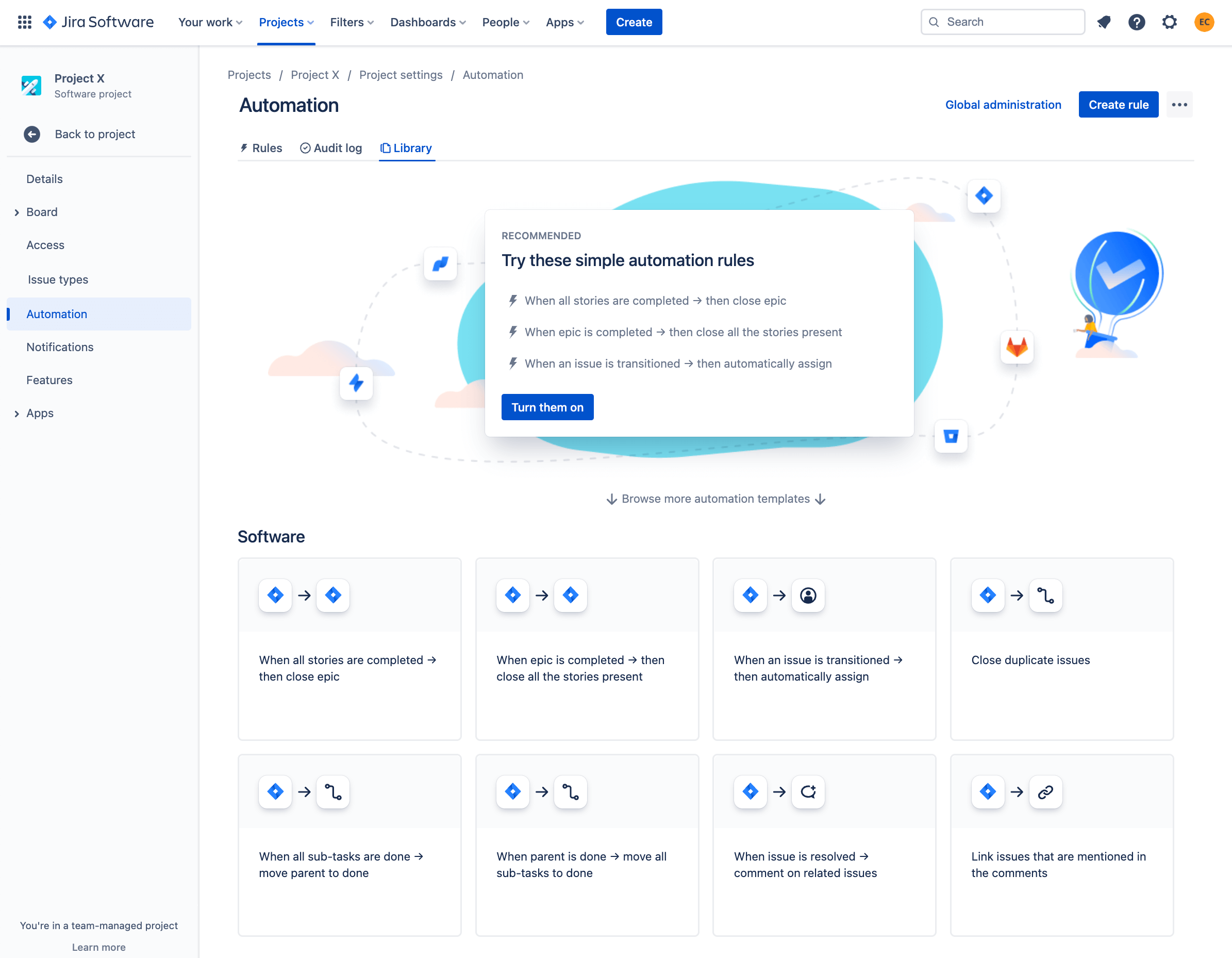Jira 自動化: 基本情報と一般的なユース ケース
Automation とは何ですか?
タスク、プロセス、ワークフローを自動化して手動作業と繰り返しタスクをなくすことで、重要な作業に集中できるようになります。コード不要のシンプルなルール ビルダーを使えば、単純な反復タスクから複雑なシナリオまで、すべてを数回のクリックで実行できる自動化ルールを作成できます。
Jira 自動化は現在、Jira Cloud と Confluence Cloud でご利用いただけます。
自動化ルールの重要な要素
自動化ルールは 3 つの部分で構成されています。ルールを開始するトリガー、ルールを絞り込む条件、サイトでタスクを実行するアクションです。
Triggers, conditions, and actions are the building blocks of automation. Simply combine these components to create rules that can do anything from auto-closing old work items to notifying specific teams when a release has been shipped.
製品ライブラリには、始めるのに役立つ自動化テンプレートがいくつかあります。

また、自動化テンプレート ライブラリに収容されているその他多くの自動化テンプレートやガイドを使用したり、学習したりできます。
トリガーとは
Every rule starts with a trigger. They kick off the execution of your rules. Triggers will listen for events in Jira, such as when a work item is created or when a field value is changed. You can also trigger rules to run from third party services like Bitbucket or GitHub.
トリガーは、設定またはスケジュールした条件に基づいて、手動で実行するように設定できます。
条件とは
Conditions allow you to narrow the scope of your rule. They must be met for your rule to continue running. For example, you can set up your rule to only escalate a work item if it is high priority.
条件が失敗した場合、ルールの実行は中止され、条件に続くアクションは実行されません。
アクションとは
Actions are the doers of your rule. They allow you to automate tasks and make changes within your site. They allow you to perform many tasks, such as editing a work item, sending a notification, or creating sub-tasks.
分岐とは
Work items in Jira rarely exist in isolation. They often contain sub-tasks, are stories that are part of a larger epic, or are simply linked to other work items using certain relationships. This means that when using automation, actions often need to apply, not only to the source work item that triggered the rule, but also to any work items that are related to the source work item.
Special conditions and actions are available to create powerful rules that can work across complex work item relationships. For example, checking that all sub-tasks of a parent work item are resolved.
スマート バリューとは
Smart values allow you to access and manipulate a wide range of work item data within your site. They can add significant power and complexity to your rules. For example, the smart value {{now.plusDays(5)}} references the current time and adds 5 days to it, while {{issue.summary}} will print off the summary of the work item.
ルール実行者とは
The rule actor is the user who executes a rule. This user must have the relevant permissions to trigger the rule, and complete any actions that may be performed. For example, if a rule is created that will comment on a work item when executed, the rule actor must have the Add comment permission, otherwise the rule will result in an error.
サイトでは、ルール アクターは自動化アプリ ユーザーとして設定されます。ただし、自動化ルールのルール アクターを変更できるようになりました。
ルール ステータスとは
自動化ルールのステータスを表示して、ルールが現在アクティブであるかそうでないかを識別できます。ルールが非アクティブである場合、有効化されないとルールは実行されません。ルールのステータスはその詳細画面で確認できます。
- 有効ルールは現在アクティブです。
- 無効ルールは現在使用されていません。
- 下書きルールの変更が未公開です。

監査ログとは
各ルールには、ルールがトリガーされた時間、実行の最終結果、実行されたすべてのアクションを確認できる監査ログがあります。
個別のルール、プロジェクト全体、または広範なレベルの監査ログを確認できます。監査ログの確認は、ルールをデバッグする効果的な方法です。
